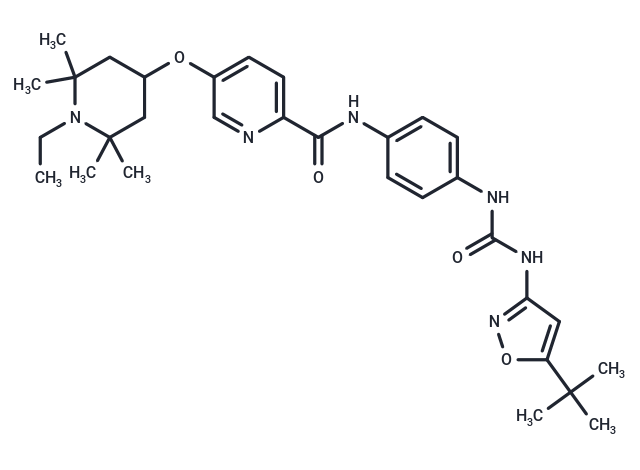Shopping Cart
- Remove All
 Your shopping cart is currently empty
Your shopping cart is currently empty

AC710 is a potent PDGFR inhibitor with Kds of 0.6 nM for FLT3, 1 nM for KIT, 1.57 nM for CSF1R, 1.3 nM for PDGFRα, and 1 nM for PDGFRβ.

| Pack Size | Price | Availability | Quantity |
|---|---|---|---|
| 5 mg | $38 | In Stock | |
| 10 mg | $59 | In Stock | |
| 25 mg | $119 | In Stock | |
| 50 mg | $178 | In Stock | |
| 1 mL x 10 mM (in DMSO) | $47 | In Stock |
| Description | AC710 is a potent PDGFR inhibitor with Kds of 0.6 nM for FLT3, 1 nM for KIT, 1.57 nM for CSF1R, 1.3 nM for PDGFRα, and 1 nM for PDGFRβ. |
| Targets&IC50 | c-Kit:1 nM (Kd), FLT3:0.6 nM (Kd), PDGFRα:1.3 nM (Kd), PDGFRβ:1 nM (Kd), CSF1R:1.57 nM (Kd) |
| In vivo | At a dosage of 0.3 mg/kg, AC710 transiently inhibits tumor growth, with rapid resumption following cessation. Doses of 3 and 30 mg/kg result in complete tumor regression and prolonged suppression of tumor volume post-treatment. Notably, administration of AC710 does not lead to bodyweight loss in treated animals across all tested doses. Further, AC710 significantly mitigates disease progression in a mouse collagen-induced arthritis (CIA) model in a dose-dependent manner, starting from a low dose of 3 mg/kg over a span of 15 days (day 0-14). At increased dosages of 10 and 30 mg/kg, AC710's effectiveness in reducing joint swelling and inflammation is comparable or slightly superior to that of dexomethasone administered at a safe dose. |
| Animal Research | The antitumor efficacy of AC710 is assessed in a subcutaneous flank-tumor xenograft model in athymic nude mice using the MV4-11cell line. AC710 is dosed at 0.3, 3, and 30 mg/kg for 2 weeks. Tumor growth and body weight are monitored. |
| Molecular Weight | 562.7 |
| Formula | C31H42N6O4 |
| Cas No. | 1351522-04-7 |
| Smiles | CCN1C(C)(C)CC(CC1(C)C)Oc1ccc(nc1)C(=O)Nc1ccc(NC(=O)Nc2cc(on2)C(C)(C)C)cc1 |
| Relative Density. | 1.180 g/cm3 (Predicted) |
| Storage | Powder: -20°C for 3 years | In solvent: -80°C for 1 year | Shipping with blue ice. | |||||||||||||||||||||||||
| Solubility Information | DMSO: 15 mg/mL (26.66 mM), Sonication and heating are recommended. | |||||||||||||||||||||||||
Solution Preparation Table | ||||||||||||||||||||||||||
DMSO
| ||||||||||||||||||||||||||

Copyright © 2015-2025 TargetMol Chemicals Inc. All Rights Reserved.